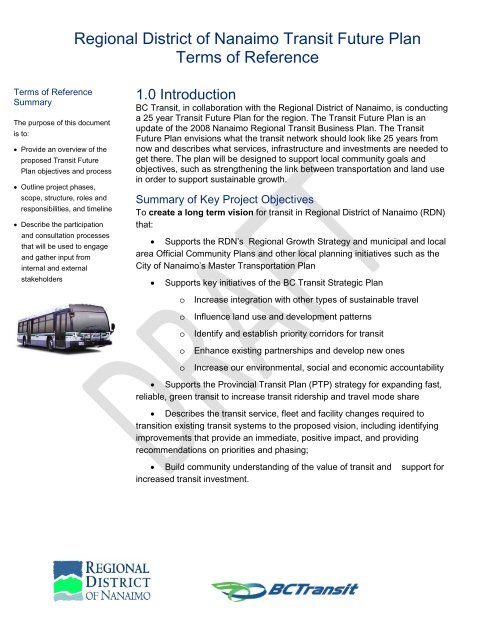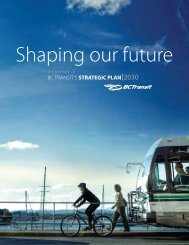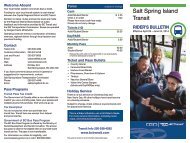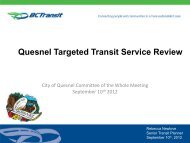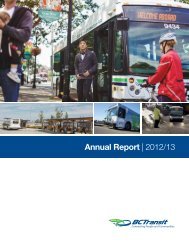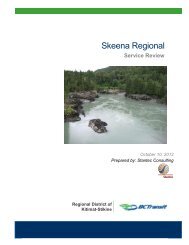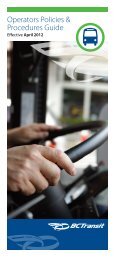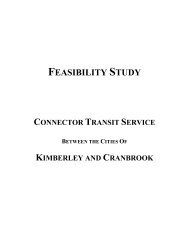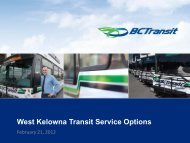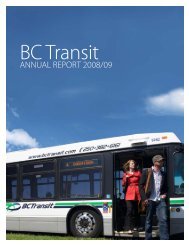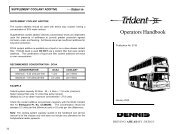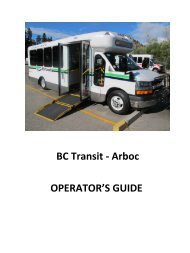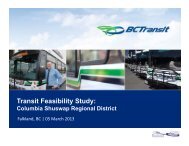Regional District of Nanaimo Transit Future Plan Terms ... - BC Transit
Regional District of Nanaimo Transit Future Plan Terms ... - BC Transit
Regional District of Nanaimo Transit Future Plan Terms ... - BC Transit
You also want an ePaper? Increase the reach of your titles
YUMPU automatically turns print PDFs into web optimized ePapers that Google loves.
<strong>Regional</strong> <strong>District</strong> <strong>of</strong> <strong>Nanaimo</strong> <strong>Transit</strong> <strong>Future</strong> <strong>Plan</strong><strong>Terms</strong> <strong>of</strong> Reference<strong>Terms</strong> <strong>of</strong> ReferenceSummaryThe purpose <strong>of</strong> this documentis to:• Provide an overview <strong>of</strong> theproposed <strong>Transit</strong> <strong>Future</strong><strong>Plan</strong> objectives and process• Outline project phases,scope, structure, roles andresponsibilities, and timeline• Describe the participationand consultation processesthat will be used to engageand gather input frominternal and externalstakeholders1.0 Introduction<strong>BC</strong> <strong>Transit</strong>, in collaboration with the <strong>Regional</strong> <strong>District</strong> <strong>of</strong> <strong>Nanaimo</strong>, is conductinga 25 year <strong>Transit</strong> <strong>Future</strong> <strong>Plan</strong> for the region. The <strong>Transit</strong> <strong>Future</strong> <strong>Plan</strong> is anupdate <strong>of</strong> the 2008 <strong>Nanaimo</strong> <strong>Regional</strong> <strong>Transit</strong> Business <strong>Plan</strong>. The <strong>Transit</strong><strong>Future</strong> <strong>Plan</strong> envisions what the transit network should look like 25 years fromnow and describes what services, infrastructure and investments are needed toget there. The plan will be designed to support local community goals andobjectives, such as strengthening the link between transportation and land usein order to support sustainable growth.Summary <strong>of</strong> Key Project ObjectivesTo create a long term vision for transit in <strong>Regional</strong> <strong>District</strong> <strong>of</strong> <strong>Nanaimo</strong> (RDN)that:• Supports the RDN’s <strong>Regional</strong> Growth Strategy and municipal and localarea Official Community <strong>Plan</strong>s and other local planning initiatives such as theCity <strong>of</strong> <strong>Nanaimo</strong>’s Master Transportation <strong>Plan</strong>• Supports key initiatives <strong>of</strong> the <strong>BC</strong> <strong>Transit</strong> Strategic <strong>Plan</strong>oooooIncrease integration with other types <strong>of</strong> sustainable travelInfluence land use and development patternsIdentify and establish priority corridors for transitEnhance existing partnerships and develop new onesIncrease our environmental, social and economic accountability• Supports the Provincial <strong>Transit</strong> <strong>Plan</strong> (PTP) strategy for expanding fast,reliable, green transit to increase transit ridership and travel mode share• Describes the transit service, fleet and facility changes required totransition existing transit systems to the proposed vision, including identifyingimprovements that provide an immediate, positive impact, and providingrecommendations on priorities and phasing;• Build community understanding <strong>of</strong> the value <strong>of</strong> transit and support forincreased transit investment.
22.0 Scope <strong>of</strong> Work<strong>Transit</strong> <strong>Future</strong> <strong>Plan</strong> Study AreaThe <strong>Regional</strong> <strong>District</strong> <strong>of</strong> <strong>Nanaimo</strong> <strong>Transit</strong> <strong>Future</strong> <strong>Plan</strong> study area includes all municipalities andpopulated areas within the RDN, even those areas currently not served by transit. The plan will includeboth the conventional and custom transit systems.Project Components1. Stakeholder and Community EngagementA. Community Engagement Approacha. Inform – Keep our stakeholders and the community up to date on project progressand how feedback can be providedb. Listen – An opportunity for our stakeholders and the community to provide feedbackon to what degree the current transit system meets the needs <strong>of</strong> the community andwhat role they see transit playing in their community moving forward.c. Report Back – At this stage we will be feeding back to the community and ourstakeholders the project vision and goals and the proposed <strong>Transit</strong> <strong>Future</strong> Networkthat were developed using background data and the feedback we heard earlier on inthe processB. The <strong>Transit</strong> <strong>Future</strong> engagement process will be integrated with any local government planssuch as the City <strong>of</strong> <strong>Nanaimo</strong>’s Transportation Master <strong>Plan</strong> engagement process whenappropriateC. Identify key stakeholders and the structure <strong>of</strong> project working groups for the <strong>Transit</strong> <strong>Future</strong><strong>Plan</strong> process. Outline key opportunities for review and feedback from each groupD. Identify key opportunities for feedback and review from the public at largeE. Discuss strategies for each public engagement opportunityF. Outline media and communications requirements including the use <strong>of</strong> web and print material2. Context – Review Local Government <strong>Plan</strong>s, Demographic Trends and the Existing <strong>Transit</strong>Business <strong>Plan</strong> and <strong>Transit</strong> SystemA. Review context information gathered as part <strong>of</strong> the City <strong>of</strong> <strong>Nanaimo</strong> Master Transportation<strong>Plan</strong> processB. Review <strong>of</strong> plans, policies and objectives related to transit, transportation, land use andgreenhouse gas emissions in the RDN. This includes, but is not limited to the <strong>Transit</strong>Business <strong>Plan</strong>, <strong>Regional</strong> Growth Strategy, Master Transportation <strong>Plan</strong>, Official Community<strong>Plan</strong> (OCP), Neighborhood <strong>Plan</strong>s and other community led plansC. Review available transit data and collect new data where requiredD. Review existing service performance, ridership stats, and efficiency measuresE. Review current travel movementsF. Identify current service gapsG. Document current contextual data including demographics, land use, and traffic patternsH. Inventory existing transit infrastructure and customer informationI. Identify key future travel movements and identify temporal patterns for these movementsJ. Forecast service levels required to meet ridership, mode split, and greenhouse gasreduction targetsK. Review projected demographic and land use trends
33. Vision and GoalsA. Lead the creation <strong>of</strong> a unified vision for transit in the region with meaningful input from localgovernments, organizations and the communityB. Determine goals to achieve the overarching vision in addition to pre-existing regional,provincial and federal goalsC. Outline policies and principles that should be adhered to system-wide4. Network Concept <strong>Plan</strong>A. Identify key transit corridors and general local route structureB. Develop the service hierarchy, identifying high priority corridors and how the local networkwill feed themC. Develop a list <strong>of</strong> facilities required to support the network including but not limited to transitstations and exchanges, Park and Ride facilities, transit priority measures and passengerinformation technologiesD. Identify the estimated fleet requirements necessary to meet service demandsE. Project the required service hours through the 25-year horizon based on proposed servicelevels and outline risks related to operating costsF. Project the required infrastructure through the 25-year horizon based on the fleet andfacilities requirements5. Implementation <strong>Plan</strong>A. Prioritize service and infrastructure improvements to incrementally reach the long rangevisionB. Identify on-going improvements to occur throughout the life <strong>of</strong> the planC. Identify value added partnership opportunitiesD. Discuss opportunities for alternative funding sourcesE. Identify supporting transportation and land use strategies that could be initiated by the RDNand local government to improve the effectiveness <strong>of</strong> the transit plan6. Final ReportA. The final report will describe the planning process, results and recommendations in additionto an executive summary tailored to a non-technical audienceB. The final report will be presented to the working groups for review prior to final approvalKey DeliverablesA. <strong>Transit</strong> <strong>Future</strong> <strong>Plan</strong> reportB. City <strong>of</strong> <strong>Nanaimo</strong> related components <strong>of</strong> final <strong>Transit</strong> <strong>Future</strong> report will be integrated into the City<strong>of</strong> <strong>Nanaimo</strong> Transportation <strong>Plan</strong>
43.0 Roles and ResponsibilitiesThe overall goal <strong>of</strong> the planning process is to ensure the final plan is reflective <strong>of</strong> community desires.This extends from our local government partners to the public. The project will have three organizedgroups to guide the development <strong>of</strong> the plan. They are as follows:• Project Steering Committee consists <strong>of</strong> the Project Owner Erinn Pinkerton, Director <strong>of</strong>Corporate and Strategic <strong>Plan</strong>ning and Project Lead James Wadsworth, Senior <strong>Transit</strong> <strong>Plan</strong>nerfrom <strong>BC</strong> <strong>Transit</strong>, Dennis Trudeau, General Manager Transportation Services & Solid Waste andDaniel Pearce, Manager, <strong>Transit</strong> Operations from the <strong>Regional</strong> <strong>District</strong> <strong>of</strong> <strong>Nanaimo</strong>. This groupis responsible for ensuring the continued health <strong>of</strong> the project and the final plan as well as beingthe key decision makers where required. Committee meetings will be held as required.• Project Working Group consists <strong>of</strong> the Project Lead James Wadsworth and Tania WegwitzManager <strong>of</strong> Operational <strong>Plan</strong>ning from <strong>BC</strong> <strong>Transit</strong> and Daniel Pearce and Peter KuziekTransportation <strong>Plan</strong>ning Coordinator from the <strong>Regional</strong> <strong>District</strong> <strong>of</strong> <strong>Nanaimo</strong>. This group willmeet on a regular basis and are responsible for the production <strong>of</strong> the plan and for providingupdates to their respective organizations. This group will regularly draw on topic experts andthe Technical Advisory Team to increase the group’s effectiveness.oTechnical Advisory Team consists primarily <strong>of</strong> the conventional and custom operatingcompany’s staff and regional district staff as needed throughout the process.• Stakeholder Advisory Group consists <strong>of</strong> staff from local municipalities, institutions, communityand business groups, residential associations and select members <strong>of</strong> the public identified tohave a vested interest in transit in the region. Members are expected to provide open, honestand constructive feedback, and should seek input from their organization and provide thatfeedback to <strong>BC</strong> <strong>Transit</strong>. This group will likely meet three times during the planning process.Major stakeholders (e.g. municipal staff members) will be engaged with more frequentlythroughout the process on a one on one basis.
54.0 ScheduleThe <strong>Transit</strong> <strong>Future</strong> process takes roughly 12 - 18 months from start to finish. The following is anindicative timeline that will be refined and confirmed by the Project Working GroupDateJune 2012July 2012Fall 2012Winter 2013Spring 2013Summer 2013Fall 2013ActivityProject startup; review and confirm project terms <strong>of</strong> referenceIntroductory presentation to RDN Select <strong>Transit</strong> Committee onthe <strong>Transit</strong> <strong>Future</strong> <strong>Plan</strong> and processPhase One Community EngagementLaunch <strong>Regional</strong> <strong>District</strong> <strong>of</strong> <strong>Nanaimo</strong> <strong>Transit</strong> <strong>Future</strong> <strong>Plan</strong>WebsiteParticipate and support the City <strong>of</strong> <strong>Nanaimo</strong> MasterTransportation <strong>Plan</strong> public open house events, which willinclude additional <strong>Transit</strong> <strong>Future</strong> Bus events throughout theRDN.Stakeholder Advisory Committee Meeting One• Review background material• Visioning exercise• Set ridership targetsComplete context reviewProject update to RDN Select <strong>Transit</strong> Committee– results <strong>of</strong>community engagement, context review and presentation <strong>of</strong>draft vision and goalsDevelop draft <strong>Transit</strong> <strong>Future</strong> NetworkStakeholder Advisory Committee Meeting Two• Review vision & goals• Review draft transit network• Identify implementation prioritiesPhase Two Community EngagementDevelop implementation plan and create draft reportStakeholder Advisory Committee Meeting 3• Review public consultation results• Review transit network and implementation prioritiesParticipate and support the City <strong>of</strong> <strong>Nanaimo</strong> MasterTransportation <strong>Plan</strong> public open house events, which willinclude additional <strong>Transit</strong> <strong>Future</strong> Bus events throughout theRDN.<strong>Transit</strong> Select Committee Update - results <strong>of</strong> communityengagement phase two and presentation <strong>of</strong> <strong>Transit</strong> <strong>Future</strong>Network, preliminary transit network and implementationprioritiesProject completion, draft final report and seek planendorsement by RDN Select <strong>Transit</strong> Committee & BoardCouncil and <strong>BC</strong> <strong>Transit</strong> Board <strong>of</strong> Directors.
6_______________________________________________Erinn Pinkerton – <strong>BC</strong> <strong>Transit</strong>Director <strong>of</strong> Corporate and Strategic <strong>Plan</strong>ning_______________________________________________Dennis TrudeauGeneral Manager Transportation Services & Solid Waste


